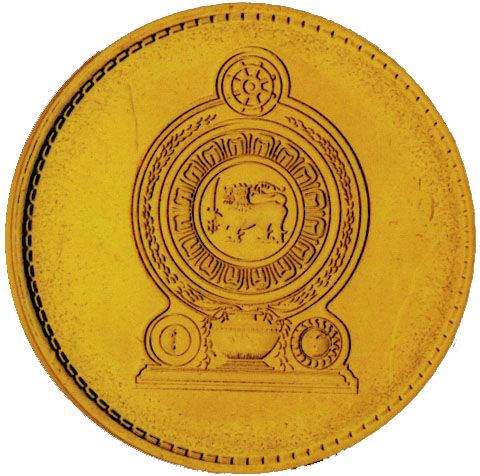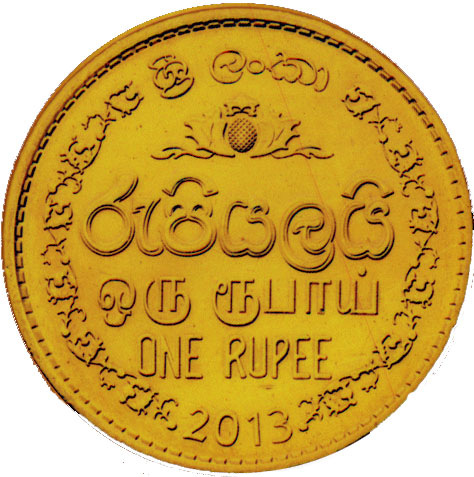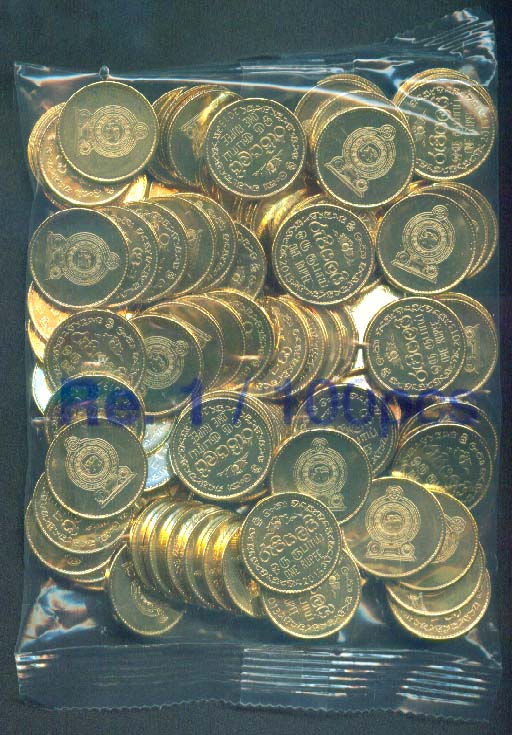| SPECIFICATIONS | |
| Denomination | One Rupee |
| Alloy | Brass plated Steel |
| Diameter | 20.0 mm |
| Thickness | 1.7 mm |
| Weight | 3.65 gms |
| Shape | Round |
| Edge | Milled + plain edge |
| DieAxis | 0° |
| Mint | Mint of Finland |


They have slight differences to the older Royal Mint coin issued previously between 2005-2011 and again in 2013 when the order with Finland was cancelled and returned to the Royal Mint. I understand it was an issue on quality. See comparison.
|

|

| ||||||||||||||||||||
| KM #136.4 | ||||||||||||||||||||||
Obverse : The Armorial Ensign of Sri Lanka within circle of dashes along periphery with raised rim.
Reverse : A traditional Sinhala design using the Pineapple motif. Value in big
රුපියලයි in Sinhala,
and smaller
ஒரு ரூபாய் in Thamil,
and ONE RUPEE
below and year of issue at the bottom,
with traditional Sinhala Liyavela art on either side, and country name
ශ්රී ලංකා (Sri Lanka) in Sinhala, centered on top. All within circle of dashes along periphery with raised rim.

| Year | Issue |
| 2013 | 3,600,000 |
In contrast to the Royal Mint Plastic bags of 1000 coins, the Finland mint coins are issued in very convenient cellophane packs of 100 coins which weighed 370 grams on a digital scale. Printed in Blue on pack is Re. 1 / 100pcs. Ten of these packs were enclosed in a larger pack with Printed in Blue Re. 1 / 1000pcs.
The Finland Mint is located in Helsinki's Katajanokka district was
founded by imperial decree on 1860 April 19th.
In 2013 March, it was awarded a
contract by CBSL to mint 150 Million Rs1 coins over the next 3 years.

| |
| 2013 Finland Mint | 2013 Royal Mint |
Name of country is still only in Sinhala, as it has been on all circulation coins one rupee and below, which still follow the basic design incorporated in 1972, based on the 1963 design. The Rs2 and Rs5 coin designs first adopted in 1984 and the Rs10 coin design adopted in 2009 have the name of country in all three languages.
In 2014 March, I first found two in circulation, before it had been reported to me by anyone.
The Brass plating appears to be much brighter almost gold-like, but thinner than the Royal Mint coins since on one of the two coins I could see the steel below the plate in the otherwise BU coin.
The grooves on the edge of the coin are less sharp.
I thank Dushanthi (PR-BoC) for getting me packs of these coins on 2014 April 2nd a week before I could have got them from CBSL. The coin was scaned at 600 dpi and the images are displayed at 300 dpi.
Inspection of these 100 coins under 10x magnification showed no significat defects other than typical bag marks.
Weighing each of the 100 coins on a digital pocket scale with a precision of 0.01 grams, I found that the coins weighed between 3.63 amd 3.76 with a mean of 3.67 grams. The distribution had a rms dispersion of 0.0266 (0.72% of mean weight). It had a positive skewness of 0.69 and was leptokuratic with an small positive excess kurtosis of +0.24. i.e. distribution more peaked than normal.
It appears that the coins lower than this range have been removed by some weight control. This would make the measured distribution with the observed positive skewness and kurtosis. This is unlike the Slovak and Royal Dutch Mint which appears to have clippbed both lower and higher of a weight range, and British Royal Mint which did not remove any coins on weight